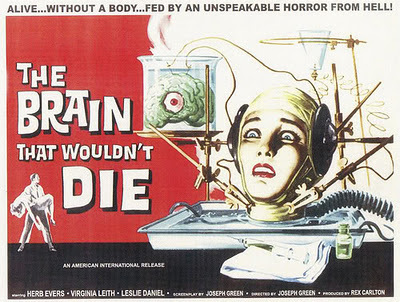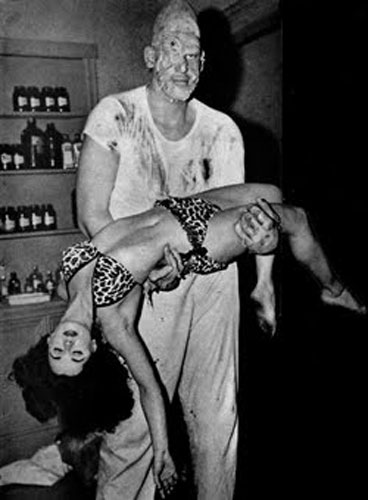 Perhaps the ultimate head-in-a-dish movie, and there’s an excellent reason for its notoriety. THE BRAIN THAT WOULDN’T DIE is unsurpassed for dumb-assed 1950s-era fun, ranking with iconic bad movies like PLAN 9 FROM OUTER SPACE and ROBOT MONSTER.
Perhaps the ultimate head-in-a-dish movie, and there’s an excellent reason for its notoriety. THE BRAIN THAT WOULDN’T DIE is unsurpassed for dumb-assed 1950s-era fun, ranking with iconic bad movies like PLAN 9 FROM OUTER SPACE and ROBOT MONSTER.
…originally titled I WAS A TEENAGE BRAIN SURGEON
THE BRAIN THAT WOULDN’T DIE, originally titled I WAS A TEENAGE BRAIN SURGEON, was shot in 13 days in 1958, but wasn’t released until 1962. The film was subjected to much censorship-enforced editing over the years, resulting in a variety of different versions, the most prevalent of which are the 70-minute TV cut and the 85 (actually 83)-minute Synapse DVD from 2000, advertised as the “complete, uncut” version—although a subsequent DVD has turned up from Platinum with a stated running time of 92 minutes.
The film’s writer-director Joseph Green (1928-1999) is known for this film and DAY-DREAM, the Americanized version of Tetsuji Takechi’s hallucinatory Japanese classic HAKUJITSUMU (1964).
Dr. Bill Carter is a surgeon who practices controversial experiments on his patients. One day he’s driving to his secluded mountain laboratory with his fiancée Jan in tow. Carter crashes his car and Jan is decapitated, with her body burned in the wreckage.
 Deciding to commence another of his experimental procedures, Carter rushes Jan’s head back to his laboratory and succeeds in keeping it alive in a dish. His aim is to keep the head living until he can find a suitable body to graft it onto. But Jan, in her new, bodiless condition, doesn’t want to live, and comes to realize she’s not the only one of Carter’s experiments trapped in the lab: Carter’s loyal assistant Kurt has an arm unsuccessfully transplanted onto his shoulder by Carter, and locked in a nearby closet is a howling mutant—with whom Jan’s head learns to telepathically communicate. That communication results in the mutant ripping off Kurt’s grafted-on arm under Jan’s command.
Deciding to commence another of his experimental procedures, Carter rushes Jan’s head back to his laboratory and succeeds in keeping it alive in a dish. His aim is to keep the head living until he can find a suitable body to graft it onto. But Jan, in her new, bodiless condition, doesn’t want to live, and comes to realize she’s not the only one of Carter’s experiments trapped in the lab: Carter’s loyal assistant Kurt has an arm unsuccessfully transplanted onto his shoulder by Carter, and locked in a nearby closet is a howling mutant—with whom Jan’s head learns to telepathically communicate. That communication results in the mutant ripping off Kurt’s grafted-on arm under Jan’s command.
Carter, meanwhile, finds the ideal body for Jan’s head after a lengthy search. The vessel is Doris, a former schoolmate whose face is horribly scarred but who possesses a mighty hot bod. Jan lures Doris to the laboratory with the intention of killing her and replacing her head with Jan’s—but he’s unaware that the mutant’s closet has been unlocked, and its inhabitant is quite hungry!
Make no mistake: this film is poorly paced, scientifically questionable (how can a decapitated head with a severed voice box talk?) and often laughably low budget (in its noticeably under-furnished sets and car crash depicted entirely via a spinning POV shot), and also outrageously exploitive (an early catfight between two strippers has no relevance to the overall narrative yet is allowed to drag on for some time). Of course it’s precisely those things that make the whole thing such a kick: its earnestness is loveable and, in this era of obnoxious ready-made “cult” cinema, even laudatory. Today’s low budget moviemakers could learn a lot from THE BRAIN THAT WOULDN’T DIE.
Today’s low budget moviemakers could learn a lot from THE BRAIN THAT WOULDN’T DIE.
The film has other standout elements. It evinces a real fascination with the grotesque that lends it an unexpectedly bizarre dimension. Note the way Dr. Carter caresses a maimed woman’s facial wounds and the outrageous soliloquies on fear and ugliness mouthed by Jan’s head, which coaxes the mutant from its confines with the priceless line “I’ve got to see your hideousness, you’ve got to see mine!” The gore quotient was unprecedented for the late 1950s, and while hardly shocking by today’s standards, helps lend THE BRAIN THAT WOULDN’T DIE an impact that other films of its ilk lack.
Vital Statistics
THE BRAIN THAT WOULDN’T DIE
American International Pictures
Director: Joseph Lewis
Producer: Rex Calton
Screenplay: Joseph Lewis
Cinematography: Stephen Hajnal
Editing: Marc Anderson
Cast: Jason Evers, Virginia Leith, Leslie Daniels, Adele Lamont, Bonnie Sharie, Paula Maurice, Marilyn Hanold, Bruce Brighton, Arny Freeman
